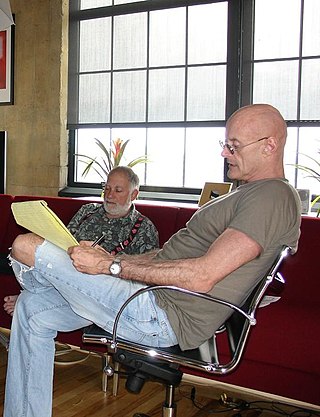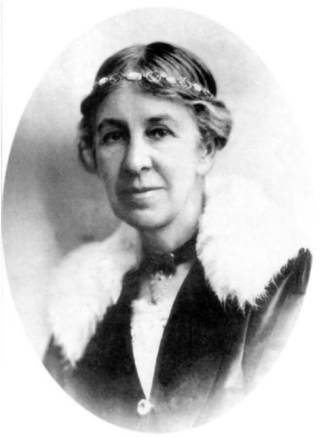
Kenneth Earl Wilber II is an American theorist and writer on transpersonal psychology and his own integral theory, a four-quadrant grid which purports to encompass all human knowledge and experience.
The following outline is provided as an overview of and topical guide to spirituality:

Evelyn Underhill was an English Anglo-Catholic writer and pacifist known for her numerous works on religion and spiritual practice, in particular Christian mysticism. Her best-known work is Mysticism, published in 1911.
Spiritual evolution, also called higher evolution, is the idea that the mind or spirit, in analogy to biological evolution, collectively evolves from a simple form dominated by nature, to a higher form dominated by the spiritual or divine. It is differentiated from the "lower" or biological evolution.
Caroline Myss is an American author of 10 books and many audio recordings about mysticism and wellness. She is most well known for publishing Anatomy of the Spirit (1996). She also co-published The Creation of Health with Dr C Norman Shealy MD - ex Harvard professor of neurology. Her most recent book, Archetypes: Who Are You? was published in 2013. Myss describes herself as a medical intuitive and a mystic.

Christian mysticism is the tradition of mystical practices and mystical theology within Christianity which "concerns the preparation [of the person] for, the consciousness of, and the effect of [...] a direct and transformative presence of God" or Divine love. Until the sixth century the practice of what is now called mysticism was referred to by the term contemplatio, c.q. theoria, from contemplatio, "looking at", "gazing at", "being aware of" God or the Divine. Christianity took up the use of both the Greek (theoria) and Latin terminology to describe various forms of prayer and the process of coming to know God.
The term involution has various meanings. In some instances it refers to a process prior to evolution which gives rise to the cosmos, in others it is an aspect of evolution, and in still others it is a process that follows the completion of evolution in the human form.

Boomeritis: A Novel That Will Set You Free is a polemical 2002 novel by American philosopher Ken Wilber, principally designed to explain Wilber's integral theory and to explain his concept of "Boomeritis". Wilber characterizes this as the deadly combination of a modern egalitarian worldview with a deep unquestioned narcissism commonly held by Baby Boomers and their children in the green meme of Spiral Dynamics, as opposed to Wilber's universal integralism.

Integral yoga, sometimes also called supramental yoga, is the yoga-based philosophy and practice of Sri Aurobindo and The Mother. Central to Integral yoga is the idea that Spirit manifests itself in a process of involution, meanwhile forgetting its origins. The reverse process of evolution is driven toward a complete manifestation of spirit.

Platonism is the philosophy of Plato and philosophical systems closely derived from it, though contemporary Platonists do not necessarily accept all doctrines of Plato. Platonism has had a profound effect on Western thought. At the most fundamental level, Platonism affirms the existence of abstract objects, which are asserted to exist in a third realm distinct from both the sensible external world and from the internal world of consciousness, and is the opposite of nominalism. This can apply to properties, types, propositions, meanings, numbers, sets, truth values, and so on. Philosophers who affirm the existence of abstract objects are sometimes called Platonists; those who deny their existence are sometimes called nominalists. The terms "Platonism" and "nominalism" also have established senses in the history of philosophy. They denote positions that have little to do with the modern notion of an abstract object.
Metaphysical naturalism is a philosophical worldview which holds that there is nothing but natural elements, principles, and relations of the kind studied by the natural sciences. Methodological naturalism is a philosophical basis for science, for which metaphysical naturalism provides only one possible ontological foundation. Broadly, the corresponding theological perspective is religious naturalism or spiritual naturalism. More specifically, metaphysical naturalism rejects the supernatural concepts and explanations that are part of many religions.
Henosis is the classical Greek word for mystical "oneness", "union" or "unity". In Neoplatonism, henosis is unification with what is fundamental in reality: the One, the Source, or Monad. The Neoplatonic concept has precedents in the Greek mystery religions as well as parallels in Eastern philosophy. It is further developed in the Corpus Hermeticum, in Christian theology, Islamic Mysticism, soteriology and mysticism, and is an important factor in the historical development of monotheism during Late Antiquity.
Metaphysics is the branch of philosophy that investigates principles of reality transcending those of any particular science. Cosmology and ontology are traditional branches of metaphysics. It is concerned with explaining the fundamental nature of being and the world. Someone who studies metaphysics can be called either a "metaphysician" or a "metaphysicist".
The following outline is provided as an overview of and topical guide to metaphysics:
Rolf Sattler FLS FRSC is a Canadian plant morphologist, biologist, philosopher, and educator. He is considered one of the most significant contributors to the field of plant morphology and "one of the foremost plant morphologists in the world." His contributions are not only empirical but involved also a revision of the most fundamental concepts, theories, and philosophical assumptions. He published the award-winning Organogenesis of Flowers (1973) and nearly a hundred scientific papers, mainly on plant morphology. As well he has contributed to many national and international symposia and also organized and chaired symposia at international congresses, edited the proceedings of two of them and published them as books.
Neoplatonism is a version of Platonic philosophy that emerged in the 3rd century AD against the background of Hellenistic philosophy and religion. The term does not encapsulate a set of ideas as much as a series of thinkers. Among the common ideas it maintains is monism, the doctrine that all of reality can be derived from a single principle, "the One".
Integral theory as developed by Ken Wilber is a synthetic metatheory aiming to unify a broad spectrum of Western theories and models and Eastern meditative traditions within a singular conceptual framework. The original basis, which dates to the 1970s, is the concept of a "spectrum of consciousness" that ranges from archaic consciousness to the highest form of spiritual consciousness, depicting it as an evolutionary developmental model. This model incorporates stages of development as described in structural developmental stage theories, as well as eastern meditative traditions and models of spiritual growth, and a variety of psychic and supernatural experiences.
Articles related to philosophy of religion include:

The Marriage of Sense and Soul: Integrating Science and Religion is a 1998 book by American author Ken Wilber. It reasons that by adopting contemplative disciplines related to Spirit and commissioning them within a context of broad science, that "the spiritual, subjective world of ancient wisdom" could be joined "with the objective, empirical world of modern knowledge". The text further contends that integrating science and religion in this way would in turn, "have political dimensions sewn into its very fabric".

In philosophy, naturalism is the idea that only natural laws and forces operate in the universe. In its primary sense, it is also known as ontological naturalism, metaphysical naturalism, pure naturalism, philosophical naturalism and antisupernaturalism. "Ontological" refers to ontology, the philosophical study of what exists. Philosophers often treat naturalism as equivalent to materialism.








